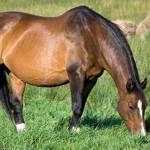Hydrops: Rare Emergency in Pregnant Mares

A rare condition called hydrops, characterized by overaccumulation of placental fluid, can occur in the last months of pregnancy. Two forms of hydrops are recognized: hydrallantois (excessive allantoic fluid) and hydramnion (excessive amniotic fluid), with hydrallantois the more often diagnosed.
Researchers are not clear why some mares develop hydrops, though placentitis, leptospirosis, fetal anomalies, and genetic predisposition have been proposed as possibilities.
The predominant hallmark of hydrallantois and hydramnion—collectively referred to as hydropsical conditions—is sudden onset of abdominal enlargement, often over a period of days to weeks (hydrallantois) or weeks to months (hydramnion).* Increases in abdominal circumference are sometimes reported to be as great as three inches (nine centimeters) per day,** and mares often show a pendulous, pear-shaped abdomen.*
As fluid buildup intensifies, mares may show labored breathing, reluctance to walk, colic-like behavior and, when especially severe, prepubic tendon rupture or abdominal wall injury and associated pain. The prepubic tendon is a strong, fibrous structure that attaches several abdominal muscles to the pubis, or floor of the pelvis bone; when the tendon fails, it cannot be repaired, though measures can be taken to reduce the mare’s discomfort. Because of the risks these clinical signs portend, hydropsical conditions should be considered medical emergencies.
Veterinarians definitively diagnose hydrops by transrectal palpation of the reproductive tract and transabdominal ultrasonography to detect abnormal fluids. In an attempt to save affected mares, owners usually opt for a procedure known as gradual transcervical drainage (GTD), which releases the fluid and, as a side effect, terminates the pregnancies. The amount of fluid extracted varies but can exceed 26 gallons (100 liters).** Most mares tolerate the procedure well. Due to the risk of hypotensive shock, mares are often administered intravenous fluids before and during the drainage procedure.
In a recent study, veterinary researchers set out to determine the survival rates of mares with hydrops and to describe the likelihood for pregnancy and foaling following treatment.++
The researchers examined the medical records of 30 mares with hydrops admitted to a veterinary hospital over the course of 11 years. Twenty-seven mares survived. Twenty of those mares had a subsequent foal; 15 had foals the year immediately following diagnosis of hydrops. No recurrence of hydrops happened in this set of mares, though follow-up on some mares proved difficult. All mares managed with GTD survived. Peritonitis secondary to abdominal wall rupture or uterine tear claimed two of the mares, and the third was euthanized after fracturing a tibia during recovery following cesarean section.
With a success rate of 90% in this retrospective study, the researchers concluded that mares have a “good prognosis for life and reproductive ability if timely aggressive medical management is performed. Treatment with GTD may allow improved survival and prevent severe complications, and is recommended.”
From a nutritional perspective, feeding behavior might change as hydrops worsens and abdominal distension progresses. Some mares will have little motivation to eat, likely because of discomfort; others will exhibit signs of colic. Inappetence might be rectified by offering the mare grass, though turnout should be directed by a veterinarian, as many mares might be restricted to stall rest.
Because of its many benefits to broodmares, EO-3 may be appropriate for mares with a history of hydrops, placentitis, or possibly a genetic tendency to hydrops. The omega-3s in EO-3, particularly DHA and EPA, support the mare’s immune system to prevent and fight infection as well as promote healthy development of the foal.
*Slovis, N.M., K.G. Lu, K.E. Wolfsdorf, and W.W. Zent. 2013. How to manage hydrops allantois/hydrops amnion in a mare. In: Proc. American Association of Equine Practitioners, p. 35-39.
**Diel de Amorium, M., T.S. Chenier, C. Card, B. Back, J.T. McClure, and P. Hanna. 2018. Treatment of hydropsical conditions using transcervical gradual fetal fluid drainage in mares with or without concurrent abdominal wall disease. Journal of Equine Veterinary Science 64:81-88.
++Lemonnier, L.C., K.E. Wolfsdorf, N. Kreutzfeldt, C. Fedorka, M. Chigerwe, and R. Bozorgmanesh. 2022. Factors affecting survival and future foaling rates in Thoroughbred mares with hydrops. Journal of Equine Veterinary Science 113:103941.








